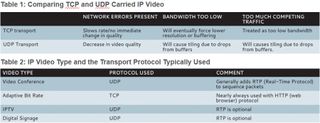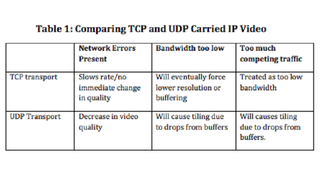In this first installment of a two-part lesson, we will discuss the difference between IP video that is carried by TCP and IP video that is carried by UDP. They behave very differently on the network. However, both can be used to deliver high quality video and audio.
First, let’s review the key differences between these two protocols. While both operate at the transport layer of the seven-layer model, they are designed for very different uses.
TCP:
- Formally establishes an understanding of the transmission parameters it will use and parameters its receiver will use as part of session start-up.
- Adapts the rate at which it transmits the video based on its understanding of the bandwidth, quality, and current available capacity of the path it has to the receiver.
- Tracks delivery of the video and retransmits any packets that are lost or corrupted.
On the other hand, UDP:
● Sends data at the rate the application prescribes. The application is responsible for any adjustment in rate, based on changes in the network quality.
● Is not able to deal with lost segments of data. That responsibility must also be handled by the application.
● May force traffic to be dropped if the network capacity is low or other traffic volume is too high.
● So, what does this mean for an application that sends IP video? Table 1 summarizes this.

In our next lesson, we’ll look at how these behave differently on the network as a result of the differences in the transport protocol that is used.
The type of video often determines which protocol generally is used. Table 2 summarizes this.
Read Part 2 of our TCP vs UDP series here:
http://www.avnetwork.com/avtechnology/byte-sized-lesson-in-av/ip-tcp-vs-udp-part-2/125411
Phil Hippensteel, PhD, teaches information systems at Penn State Harrisburg. He is a regular contributor to AV Technology.

